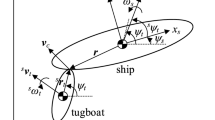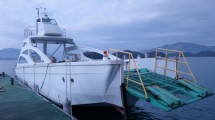Abstract
In this paper, we propose a new approach to ship berthing by using autonomous tugboats. This approach overcomes the nominal effectiveness problem of actuators at slow speed maneuvering to improve the ship operation in the harbor area. The proposed SMC gave us a sliding mode control law that guarantees position tracking with desired velocity in the presence of environmental disturbances. The thrust allocation problem is solved by using a redistributed pseudo-inverse (RPI) algorithm to determine the thrust and direction of each individual tugboat. The main goal of RPI method is to minimize the power supplied to tugboats and increase their controllability. The proposed approach has been simulated on a model of a supply vessel with excellent results.
Similar content being viewed by others
References
R. Skjetne, T. I. Fossen, and P. V. Kokotovic, “Adaptive output maneuvering, with experiment, for a model ship in a marine control laboratory,” Automatica, vol. 41, no. 2, pp. 289–298, 2005.
C. Jammazi, “Backstepping and partial asymptotic stabilization: application to partial attitude control,” International Journal of Control, Automation, and System, vol. 6, no. 6, pp. 859–872, 2008.
S. M. Lee, K. Y. Kwon, and J. Joh, “A fuzzy logic for autonomous navigation of marine vehicles satisfying COLREG guidelines,” International Journal of Control, Automation, and System, vol. 2, no. 2, pp. 171–181, 2004.
K. Hasegawa and T. Fukutomi, “On harbor maneuvering and neural control system for berthing with tug operation,” Proc. of the 3rd International Conference on Maneuvering and Control of Marine Craft, pp. 197–210, UK, 1994.
C. H. Hong, K. C. Choi, and B. S. Kim, “Applications of adaptive neural network control to an unmanned airship,” International Journal of Control, Automation, and System, vol. 7, no. 6, pp. 911–917, 2009.
I. M. Namkyun and K. Hasegawa, “A study on automatic ship berthing using parallel neural controller,” The Journal of Kansai Society of Naval Architects of Japan, vol. 237, no. 3, pp. 127–132, 2002.
R. Zhang, Y. Chen, Z. Sun, F. Sun, and H. Xu, “Path control of a surface ship in restricted waters using sliding mode,” Trans. on Control System Technology, vol. 8, no. 4, pp. 722–732, 2000.
H. Ashrafiuon and K. Muske, “Sliding mode control of surface vessels,” Proc. of American Control Conference, pp. 556–562, USA, 2008.
A. J. Healey and D. Lienard, “Multivariable sliding mode control for autonomous diving and steering of unmanned underwater vehicles,” Journal of Ocean Engineering, vol. 18, no. 3, pp. 327–339, 1993.
C. Vuilmet, “High order sliding mode control applied to a heavyweight torpedo,” Proc. of IEEE Conference on Control Applications, pp. 61–66, Canada, 2005.
K. A. Bordingnon, Constrained Control Allocation for Systems with Redundant Control Effectors, Ph.D. Thesis, Dept. Aerospace & Ocean Eng., Virginia Polytechnic Institute & State Univ., Blacksburg, VA, 1996.
T. I. Fossen, Marine Control System-Guidance, Navigation and Control Ships, Rigs and Underwater Vehicle, Norwegian University of Science and Technology, Trondheim, Norway, 2002.
J. P. Strand, Nonlinear Position Control System Design for Marine Vessels, Ph.D. Thesis, Dept of Engineering Cybernetics, Norwegian University of Science and Technology, 1999.
Author information
Authors and Affiliations
Corresponding author
Additional information
Recommended by Editorial Board member Hamid Reza Karimi under the direction of Editor Jae Weon Choi.
This research was a part of the project titled “The Development of Mooring Position Control System for Offshore Accommodation Barge” funded by the Ministry of Land, Transport and Maritime Affairs, Korea.
Van Phuoc Bui obtained his B.S. in Mechatronic Engineering in 2005 at Ho-ChiMinh University of Technology (HCMUT) and his M.S. in the Graduate School of Mechanical and Control System Engineering in 2009 at Pukyong National University (PKNU), Busan, Korea. He is currently a doctoral student at PKNU. His research interests include control theory with applications to marine control system.
Young-Bok Kim received his B.S. and M.S. degrees in Maritime Engineering from National Fisheries University of Pusan, Korea in 1989 and 1991, respectively. He received his Ph.D. degree from Kobe University, Japan in 1996. Dr. Kim is currently a Professor at the Department of Mechanical System Engineering at Pukyong National University in Busan, Korea. His research interests include control theory and application with Dynamic Ship Positioning and crane control system design.
Rights and permissions
About this article
Cite this article
Van Bui, P., Kim, Y.B. Development of constrained control allocation for ship berthing by using autonomous tugboats. Int. J. Control Autom. Syst. 9, 1203–1208 (2011). https://doi.org/10.1007/s12555-011-0622-4
Received:
Revised:
Accepted:
Published:
Issue Date:
DOI: https://doi.org/10.1007/s12555-011-0622-4




